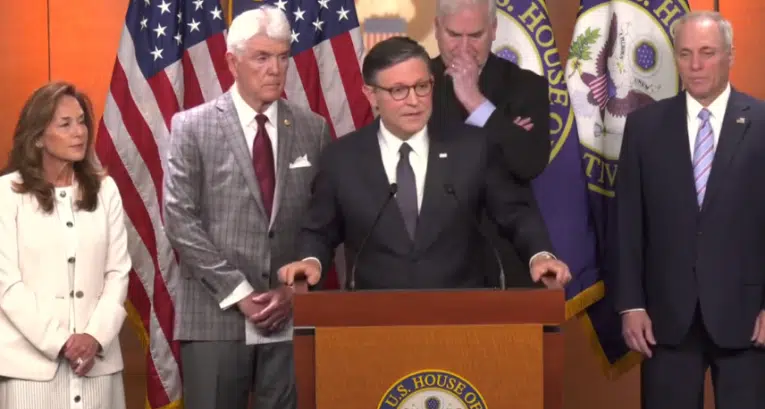To hear House Speaker Nancy Pelosi tell it, President Donald Trump’s efforts to reform the Postal Service — which began with an April 2018 executive order appointing a task force to bring USPS into solvency almost two years before there was any COVID-19 pandemic — were intended to undermine increased requests for mail-in and absentee ballots in 2020 in response to the pandemic.
In an Aug. 16 dear colleague letter, Pelosi alleged, “Alarmingly, across the nation, we see the devastating effects of the President’s campaign to sabotage the election by manipulating the Postal Service to disenfranchise voters. Postmaster General Louis DeJoy, one of the top Trump mega-donors, has proven a complicit crony as he continues to push forward sweeping new operational changes that degrade postal service, delay the mail, and… threaten to deny the ability of eligible Americans to cast their votes through the mail in the upcoming elections in a timely fashion.”
It’s a conspiracy theory. For it to be true, Trump and the Postal Service had to know in 2018 there would be a global pandemic in 2020 and that states would extend deadlines associated with mail-in and absentee ballots which would preclude timely delivery by the Postal Service.
Pelosi’s dear colleague letter came, not after Trump began appointing his task force in 2018 or when the task force delivered its findings in Dec. 2018, but after the Washington Post reported on Aug. 14 that the Postal Service had sent letters to 46 states and the District of Columbia warning that, given state deadlines for sending out and casting ballots that are “incongruous” with how long it takes to actually deliver mail, it cannot guarantee all ballots will be counted in time for Election Day.
For example, in the letter sent to Missouri Secretary of State dated July 31, USPS Vice President and General Counsel Thomas Marshall warned “under our reading of Missouri’s election laws, certain deadlines for requesting and casting mail-in ballots may be incongruous with the Postal Service’s delivery standards… it is particularly important that voters be made aware of the transit times for the mail (including mail-in ballots) so that they can make informed decisions about whether and when to (1) request a mail-in ballot, and (2) mail a completed ballot back to election officials.”
The letter recommended that the voters request ballots no later than 15 days before Election Day, or Oct.19, that election officials should use first-class mail and not third-class mail to send blank ballots and allow one week for delivery to voters, and that voters should mail in their ballots no later than Oct. 27, a week before the election on Nov. 3, in order to be counted in time.
The Postal Service reports that first class mail takes 2-5 days to deliver and receives higher priority than third-class or marketing mail, which can take 3-10 days to deliver.
So, voters and states are being warned months ahead of time that many states’ new extended deadlines the 2020 election and mail-in ballots are problematic and may need to be modified so that ballots are sent and received on time, and to only use first-class mail to deliver the ballots to guarantee timely delivery. Here, the Postal Service is rightly raising red flags about states’ election planning — so that the states can adjust their deadlines accordingly and we don’t have a catastrophe on Election Day and the weeks that follow.
In any given election year, about one-quarter of ballots will be either mail-in or absentee, according to the U.S. Election Assistance Commission. It was 23.6 percent in 2016, 25.9 percent in 2012 and 19.2 percent in 2008. But in 2020, the number is projected to be much, much higher, not because of some far-fetched Trump-Postal Service conspiracy, but because of the virus.
The solution is for states to institute proper deadlines for requesting and receiving ballots that will allow for timely delivery.
And that would be the case whether President Trump’s efforts to reform the U.S. Postal Service that began in 2018 were taking place or not. On April 12, 2018, the President issued an executive order appointing a task force on the U.S. Postal Service with the goals of “the expansion and pricing of the package delivery market and the USPS’s role in competitive markets… the decline in mail volume and its implications for USPS self-financing and the USPS monopoly over letter delivery and mailboxes… the definition of the ‘universal service obligation’ in light of changes in technology, e‑commerce, marketing practices, and customer needs … the USPS role in the U.S. economy and in rural areas, communities, and small towns; and …the state of the USPS business model, workforce, operations, costs, and pricing.”
According to the Congressional Research Service, in FY 2019 the Postal Service had a $9 billion operating budget deficit, with an $80 billion budget but only $71 billion of revenue. 2020 will be even worse.
Nobody cared then. There were no dramatic press conferences called by House Speaker Nancy Pelosi or other top national Democratic leaders in Congress. No demands for additional funding outside the normal course of budget negotiations or concerns expressed about the integrity of elections. Nothing.
Then, again, in Dec. 2018, the task force the President appointed delivered its recommendations, “United States Postal Service: A Sustainable Path Forward.”
The recommendations included:
- “overhaul the USPS’s business model in order to return it to sustainability…”
- “the [Universal Service Obligation] must distinguish between the types of mail and packages for which a strong social or macroeconomic rationale exists for government protection … versus those types of mail and packages that are commercial in nature.”
- “The USPS should have the authority to charge market-based prices for both mail and package items that are not deemed ‘essential services’… [to] allow the USPS to optimize its income in order to fund its operations, capital expenditures, and long-term liabilities.”
- “The USPS must pursue new cost-cutting strategies that will enable it to meet the changing realities of its business model. These should include evaluating modifications to delivery processing standards, and the expanded use of private sector partners in areas such as processing and sortation.”
- “The USPS [should] more closely align wages for both its career and non-career workers with those of other federal employees, drawing from like examples in the broader labor market.”
That was in Dec. 2018, about a year before there was any COVID-19. In short, the Postal Service should charge more, especially for non-essential, commercial deliveries like Amazon, contract out certain functions including processing where needed and address labor costs.
And again, not so much as a peep from House Speaker Pelosi or Democratic leaders at the time of the proposals, which really are not that controversial and mirror recommendations that have been made over the years by similar task forces, such as the one from 2003.
Yet the entire country is supposed to drop everything and assume that Speaker Pelosi is giving the American people all the facts about this issue. She isn’t. She’s had a proposal to increase Postal Service funding by $25 billion, including $3.5 billion for election services, since April, to accommodate additional mail-in voting.
And for Pelosi, it’s simple how to get it done. As President Trump clearly stated at his Aug. 14 press conference, “Sure, if they give us what we want. And it’s not what I want, it’s what the American people want.”
Trump wants another coronavirus relief funding package, and explained his terms: “I’ve directed the Secretary of the Treasury to get ready and send direct payments — $3,400 for a family of four — to all Americans. Democrats are holding this up. I am ready to have the UST and SBA send additional PPP payments to small businesses that have been hurt by the China virus. Democrats are holding this up. So we’re talking about — those are two things directly involved and, really, victim of the China virus. We’re ready to send; Democrats are holding up. I’m ready to send rental assistance payments to hardworking Americans that have been hurt by the China virus. All of these things are in a list. Democrats are holding this up. I’m ready to send $105 billion to the states to help open schools safely, with additional PPP — E. And Democrats are holding this up. So that’s $105 billion to the states to help open schools safely, with additional PPE. Democrats are holding that up. Right? And I’m ready to send more money to states and local governments to save jobs of our great police, our firefighters, our first responders and teachers. It’s all ready to go. Democrats are holding it up.”
So, agree or disagree with the President’s demands for additional spending, the hold-up for the additional funding for the Postal Service that Pelosi is demanding has almost nothing to do with President Trump’s proposed Postal Service reforms. The hold-up is legislative and it is political. Each side has priorities they want to see in any new legislation. No bill can become law without President Trump’s signature unless Pelosi has the votes to override a veto. She doesn’t, and so it’s called, make a deal, or don’t make a deal. That’s up to Speaker Pelosi.
Robert Romano is the Vice President of Public Policy at Americans for Limited Government.






